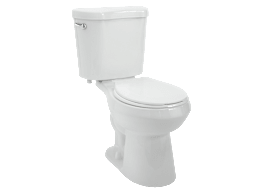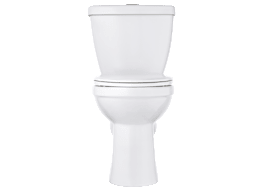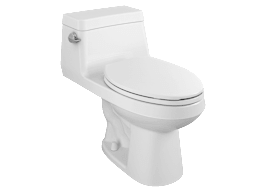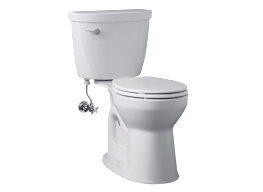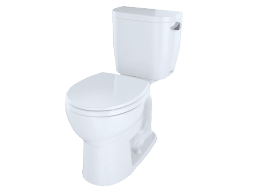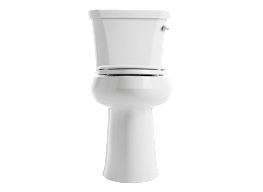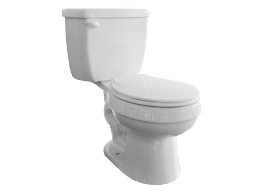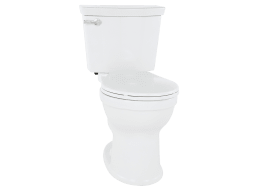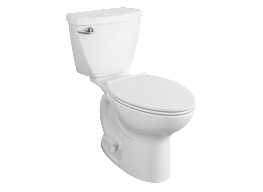Pros and Cons of Wall-Mounted Toilets
These pricey fixtures can work with any bathroom remodel. But are they worth it?
When you shop through retailer links on our site, we may earn affiliate commissions. 100% of the fees we collect are used to support our nonprofit mission. Learn more.
You’ve probably seen wall-mounted toilets, for the most part, in commercial buildings and public spaces: With flush buttons embedded neatly in the wall and bowls that hover above the ground, these toilets cut a sleek silhouette. But you could also install one in your own home, giving your bathroom a clean, modern look and a pleasant sense of separation from the murky workings of your plumbing.
The mechanisms that power a wall-mounted toilet are installed behind the wall, hiding them from view. A cast-iron or steel carrier is affixed between two wall studs and houses the tank, made of lightweight plastic and plastic foam; the carrier also supports the toilet bowl, which is anchored through the drywall, so the bowl doesn’t touch the floor.
Pros of Wall-Mounted Toilets
Wall-mounted toilets have some advantages over standard toilets, mostly in terms of creating a particular look and feel. This may seem merely a stylistic point, but in fact it can go a long way in making your bathroom more comfortable and accessible, too.
They save space. In addition to offering a more streamlined look, this setup saves space in the bathroom. Wall-mounted toilets can save as much as 10 inches by moving the tank into the wall. This makes an especially big difference if you have a small bathroom to begin with: It’ll give you more room to maneuver in front of the toilet, and without a base that touches the floor, the space will feel a little more open and tidy.
They’re easier to clean. Because the toilet hovers above the floor and the tank is inside the wall, it leaves much less toilet to clean: All you need to deal with is the bowl and seat. It also makes cleaning the bathroom floor easier because you don’t have to work around the base of a regular toilet where it meets the floor.
They’re built to code. With their compact size, wall-mounted toilets offer more flexibility when designing or updating a bathroom. “These toilets can possibly meet building-code clearances where floor-mounted toilets might not,” says John Banta, the test engineer who oversees CR’s toilet tests. In some municipalities, building codes require at least 21 inches in front of the toilet. That’s an easy criterion to meet, given that, as we mentioned above, wall-mounted toilets can be set back up to 10 inches toward the wall compared with regular toilets. The height of the toilet from the floor can also be customized: It can be adjusted to sit 17 to 19 inches off the ground, which is the Americans with Disabilities Act standard for toilet seats.
Cons of Wall-Mounted Toilets
While wall-mounted toilets have a few benefits over floor-mounted models, there are some disadvantages to be aware of, mostly in terms of the cost and renovation work that these toilets require.
They’re more expensive than standard toilets. Whereas a standard toilet can cost less than $200, the combined components of a wall-mounted toilet tend to total upward of $600. Though you can often buy the toilet bowl and the in-wall carrier together as a package, you’ll find that many manufacturers sell each of those items, as well as the tank, separately, so you’ll have to be extra careful to choose components that are designed to work together.
The cost of labor is high. For most people, this is not a do-it-yourself project, Banta says. “Depending on your circumstances, you might spend several hundred more to move the supply and waste lines or to reconfigure the studs,” he says. “It will be significantly more expensive to switch from an existing floor to a wall-mounted toilet.” While installation of a standard toilet can cost between $150 and $300, installation of a wall-mounted toilet is more likely to start around $500 and possibly cost up to or over $1,000, depending on where you live and the amount of work that needs to be done.
It takes substantial work to install. Switching from a standard floor-mounted toilet to a wall-mounted unit usually requires opening a wall, rerouting the waste pipe, and likely patching the floor tile where your old toilet was. You’ll need a wall that is thick enough to contain the concealed tank. This is usually a minimum of 10 inches in thickness, depending on the toilet model you’ve selected. You also need to know whether your framing consists of 2x4 or 2x6 studs when choosing the tank, because manufacturers make carriers for both types. “If you’re installing one of these in an older home, you would likely need to rework the studs to get them in the proper location for the carrier,” Banta says.
It’s harder to access the tank. While you will still have access to the tank—you can remove the flush button panel to get to it—it’s not as easy as lifting off the lid of a typical toilet tank, and it’ll be harder to both see and reach inside the tank to troubleshoot a problem. You may encounter issues that require you to call a plumber or handyman to access the plumbing inside the wall, which adds to the cost of maintaining a wall-mounted toilet in the long run.
Bidets are trickier to install. With a standard toilet, you can install a bidet attachment or bidet seat yourself by shutting off the water supply and replacing the existing toilet valve with a two-pronged valve, which redirects some of the water to the bidet. But if your plumbing is entirely behind a wall, you may have to call a plumber or handyman to do this for you. For bidets with an electrical hookup, which need to be plugged in to work, you need an outlet nearby, and the cords will leave the toilet area less neat and streamlined than you might have envisioned with a wall-mounted toilet.
How CR Tests Toilets
To develop our toilet ratings, CR test engineers put the fixtures through a series of tests involving waste removal, bowl cleaning, and drain line clogs. To test solid waste removal, we add marble-sized plastic beads, weighted sponges, and filled water bags into the bowl and measure how well each flush handles our simulated waste.
We test a toilet’s bowl-cleaning abilities by painting a line along the inside and judging how much of the paint remains after flushing. Finally, we observe how well a toilet pushes waste through the drain once it has been flushed. That especially matters if your waste line travels a long way to the sewer.
We put wall-mounted toilets through the same tests we use for floor-mounted toilets—though we built special rigs for each tank carrier. Generally, the wall-hung fixtures performed about the same as standard toilets.
Best Wall-Mounted Toilets
The two wall-mounted toilets in our ratings both meet the Environmental Protection Agency’s WaterSense standard, meaning they use an average of just 1.28 gallons per flush. And because you can install the toilet bowl at your desired height, they’re also able to meet the Americans with Disabilities Act “comfort height” standard, which requires the seat to be between 17 and 19 inches from the ground. Both toilets also performed on a par with the top toilets in our tests.

















